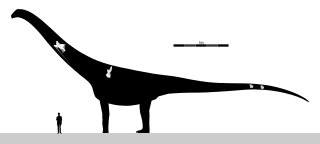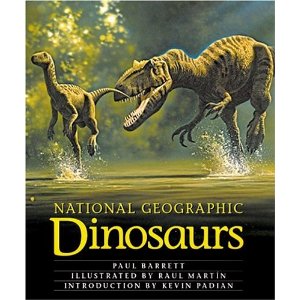
Argentinosaurus is a genus of giant sauropod dinosaur that lived during the Late Cretaceous period in what is now Argentina. Although it is only known from fragmentary remains, Argentinosaurus is one of the largest known land animals of all time, perhaps the largest, measuring 30–35 m (98–115 ft) long and weighing 65–80 t. It was a member of Titanosauria, the dominant group of sauropods during the Cretaceous. It is regarded by many paleontologists as the biggest dinosaur ever, and perhaps lengthwise the longest animal ever, though both claims have no concrete evidence yet.

Giganotosaurus is a genus of large theropod dinosaur that lived in what is now Argentina, during the early Cenomanian age of the Late Cretaceous period, approximately 99.6 to 95 million years ago. The holotype specimen was discovered in the Candeleros Formation of Patagonia in 1993 and is almost 70% complete. The animal was named Giganotosaurus carolinii in 1995; the genus name translates to "giant southern lizard", and the specific name honors the discoverer, Ruben Carolini. A dentary bone, a tooth, and some tracks, discovered before the holotype, were later assigned to this animal. The genus attracted much interest and became part of a scientific debate about the maximum sizes of theropod dinosaurs.

Carcharodontosaurus is a genus of carnivorous theropod dinosaur that lived in North Africa from about 100 to 94 million years ago during the Cenomanian age of the Cretaceous. Two teeth of the genus, now lost, were first described from Algeria by French paleontologists Charles Depéret and Justin Savornin as Megalosaurus saharicus. A partial skeleton was collected by crews of German paleontologist Ernst Stromer during a 1914 expedition to Egypt. Stromer did not report the Egyptian find until 1931, in which he dubbed the novel genus Carcharodontosaurus, making the type species C. saharicus. Unfortunately, this skeleton was destroyed during the Second World War. In 1995 a nearly complete skull of C. saharicus, the first well-preserved specimen to be found in almost a century, was discovered in the Kem Kem Beds of Morocco; it was designated the neotype in 1996. Fossils unearthed from the Echkar Formation of northern Niger were described and named as another species, C. iguidensis, in 2007.

Museo Municipal Carmen Funes, or, the Carmen Funes Municipal Museum, is a museum of paleontology in Plaza Huincul, Neuquén Province, Argentina. It is best known for its collection of dinosaur fossils, including the only specimen of the largest recorded dinosaur remains, Argentinosaurus huinculensis, and the only known sauropod embryos, which were discovered at a huge nesting site in Auca Mahuida, Patagonia. Its standard abbreviation is MCF-PVPH, or just PVPH to denote the paleontological collection.

Buitreraptor is a genus of dromaeosaurid dinosaurs that lived during the Late Cretaceous of Argentina at the Candeleros Formation. Buitreraptor was described in 2005 and the type species is Buitreraptor gonzalezorum. It was rooster-sized and had a very elongated head with many small teeth.

Carcharodontosauridae is a group of carnivorous theropod dinosaurs. In 1931, Ernst Stromer named Carcharodontosauridae as a family, which, in modern paleontology, indicates a clade within Carnosauria. Carcharodontosaurids include some of the largest land predators ever known: Giganotosaurus, Mapusaurus, Carcharodontosaurus, and Tyrannotitan all rivaled Tyrannosaurus in size. Estimates give a maximum weight of 8–10 metric tons for the largest carcharodontosaurids, while the smallest carcharodontosaurids were estimated to have weighed at least 500 kilograms (1,100 lb).

Rodolfo Aníbal Coria, is an Argentine paleontologist.

Megaraptor is a genus of large theropod dinosaur that lived in the ages of the Late Cretaceous. Its fossils have been discovered in the Patagonian Portezuelo Formation of Argentina, South America. Initially thought to have been a giant dromaeosaur-like coelurosaur, it was classified as a neovenatorid allosauroid in previous phylogenies, but more recent phylogeny and discoveries of related megaraptoran genera has placed it as either a basal tyrannosauroid or a basal coelurosaur with some studies still considering it a neovenatorid.

Mapusaurus was a giant carcharodontosaurid carnosaurian dinosaur from Argentina during the Turonian age of the Late Cretaceous.

Puertasaurus is a genus of sauropod dinosaur that lived in South America during the Late Cretaceous Period. It is known from a single specimen recovered from sedimentary rocks of the Cerro Fortaleza Formation in southwestern Patagonia, Argentina, which probably is Campanian or Maastrichtian in age. The only species is Puertasaurus reuili. Described by the paleontologist Fernando Novas and colleagues in 2005, it was named in honor of Pablo Puerta and Santiago Reuil, who discovered and prepared the specimen. It consists of four well-preserved vertebrae, including one cervical, one dorsal, and two caudal vertebrae. Puertasaurus is a member of Titanosauria, the dominant group of sauropods during the Cretaceous.

When Dinosaurs Roamed America is a two-hour American television program that first aired on the Discovery Channel on July 15, 2001. The show features the reign of the non-avian dinosaurs in America over the course of more than 160 million years, through five different segments, each with their own variety of flora and fauna.

National Geographic Dinosaurs is a nonfiction reference book on dinosaurs, written by Paul Barrett, with illustrations by Raúl Martín, and an introduction by Kevin Padian. It was published in 2001 by National Geographic.
Plaza Huincul is a small city in Neuquen province, with a population of around 13,000 people, located in southwestern Argentina. It is approximately 1,288 km (800 mi) south-west from the capital, Buenos Aires. Plaza Huincul is located in the middle of the desert and grew due to an oil discovery in the area in 1918. It is said that the largest fossils in the world are found there; such as Argentinosaurus, Giganotosaurus, and Mapusaurus.

Taurovenator is a large carcharodontosaurid theropod from the late Cretaceous Huincul Formation of Argentina that lived during the Cenomanian age of the Late Cretaceous. It is monotypic, containing only one species, T. violantei.

Murusraptor is a genus of carnivorous megaraptoran theropod dinosaur from the Sierra Barrosa Formation, part of the Neuquén Group of Patagonia, in Argentina, South America. It is known from a single specimen that consists of a partial skull, ribs, partial pelvis, leg and other assorted skeletal elements.
Leonardo Salgado is an Argentine palaeontologist with a special interest in dinosaurs of the Cretaceous period and other investigations of the palaeobiology of fossil bearing geological formations. Salgado is the leading or coauthor of several taxa, notably the large carnivorous species, Giganotosaurus carolinii, discovered in Patagonia.

The Ernesto Bachmann Paleontological Museum (MEB) in Villa El Chocón, Neuquén Province, Argentina, is a municipal museum dedicated to the paleontology, archaeology and history of Villa El Chocón and its surroundings.

Lajasvenator is a genus of carcharodontosaurid dinosaur from the Mulichinco Formation from Neuquén Province in Argentina. The type and only species is Lajasvenator ascheriae. It was probably one of the smallest known allosauroids, being approximately only half the length of Concavenator, about 2.9 m (9.5 ft).
Kaikaifilusaurus is an extinct genus of rhynchocephalians in the family Sphenodontidae from the Late Cretaceous of South America. Fossils of the genus were found in Cenomanian sediments of the Candeleros Formation and Turonian layers of the Huincul Formation, both of the Neuquén Basin and the Albian strata of the Cerro Barcino Formation in the Cañadón Asfalto Basin, all in Patagonia, Argentina. The genus contains two species, K. minimus and the type species K. calvoi.

Meraxes is a genus of large carcharodontosaurid theropod dinosaur from the Late Cretaceous Huincul Formation of Patagonia, Argentina. The genus contains a single species, Meraxes gigas.
















